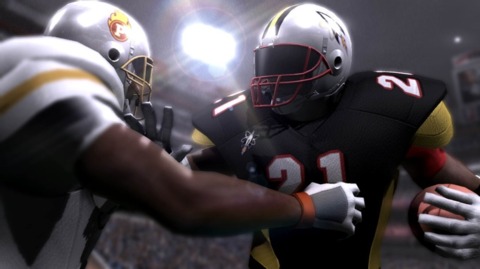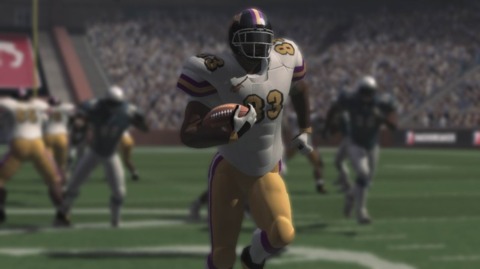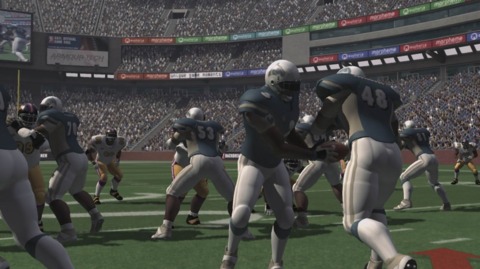Backbreaker: Every Play is Different
While the makers of Backbreaker are loathe to make direct reference to the Madden series when talking about their game, the very fact that they're creating a football game in 2009 means that such comparisons are inevitable. The unlicensed football game, under development by the folks at...
While the makers of Backbreaker are loathe to make direct reference to the Madden series when talking about their game, the very fact that they're creating a football game in 2009 means that such comparisons are inevitable. The unlicensed football game, under development by the folks at NaturalMotion (better known for its behind-the-scenes game technology, namely the Euphoria 3D simulation engine that has been used in such games as Star Wars: The Force Unleashed and Grand Theft Auto IV), is not just the first stand-alone retail game from the company, but one that is being carried as a football sim--one that looks to try to take back some of the market share dominated these last few years by EA Sports' juggernaut football franchise.
It's an uphill battle, to be certain. Not only does EA possess an exclusive stranglehold on arguably the most valuable sports license in the country (if not the world), but the Madden series has more than 20 years of development momentum behind it, with a loyal fan base of hardcore football experts and casual armchair quarterbacks alike. Announced several years ago, Backbreaker has only been seen behind closed doors--I last saw a very limited tech demo of the game back at the 2008 Games Convention in Leipzig. Last week, in Los Angeles for E3 2009, NaturalMotion representatives showed off the latest build of the game for the press; one that shows promise but still has a way to go before it's ready to be taken seriously as a Madden contender.
The one aspect of Backbreaker that intrigued me above all else was the development team and, in particular, the team's country of origin. NaturalMotion is based in Oxford, England (though it does have a San Francisco office), and during the E3 demo, NaturalMotion CEO and cofounder Torsten Reil (originally from Germany) and Backbreaker associate producer Rob Donald (a Brit) showed off the game. One of my most pressing questions to Reil and Donald was this: How aware of American football was the team before this project began?
"We had some awareness, but I've certainly become a lot more aware ever since then," said Reil. "I've also become, interestingly, a bigger American football fan than I am a soccer fan. For some reason, I find it a much more interesting sport. I shouldn't say this as a European, but I never really got into soccer that much because, to me, there's just not enough happening; there's not enough information during the game. Whereas in football, obviously, there's a lot of stuff that always happens. Every play is different."
So how did a British company headed by a German CEO decide on American football as its retail debut?
"The initial reason why we wanted to do American football is because we were quite familiar with the football games that were out there and we thought there is a completely different way of doing it," Reil told me. "That basically was the initial idea: the different camera position and [to] make everything properly live."
By "properly live," Reil refers to the game's Euphoria-engine-powered gameplay, which, according to the company, ensures that contact between players--be it a quarterback sack, a potential strip of the ball by a cornerback on a wideout, or two beefy linemen working it out in the trenches--is unique every time the ball is snapped. From the looks of the E3 demo, which featured a first glimpse at actual 11-on-11 gameplay, these promised unique moments are not in short supply.
Even better news: Unlike the tech demo shown at Leipzig last year, Backbreaker is now starting to look more like a game than ever. The Tackle Alley demo once again kicked off our demo, but now, instead of feeling like a technical display, it looked and felt more like a traditional minigame, with you running your player through a series of increasingly difficult challenges as you try to evade tacklers and get to the end zone. The number of defenders increases as you go, and, in some challenges, you'll only be able to navigate through a specific chunk of the field. Also, the game now features a traditional front end, complete with a rotating mix of game modes. From the looks of things, there's going to be more to do than the Tackle Alley and simple exhibition games, but the developers are keeping the full game mode list under wraps for now.
After spending some time in Tackle Alley, the demo moved on to true 11-on-11 play which, though still tightly controlled for the demo, marks another milestone of progression for the game. The first glimpse of full-team play was shown via Training Camp mode. The mode on hand had six available plays (three offensive and three defensive) to choose from and served not only as an introduction to how Backbreaker will be played from a control standpoint, but also as a way of showing how Backbreaker works as a football game.
The most noticeable aspect of the game is its camera, which is set down low near the quarterback (or other ball carrier), giving the player an on-field perspective that's quite a bit different from the traditional top-down Madden view. As quarterback, you can switch focus between primary receivers, first by entering "focus mode" when you press the left trigger and then moving the right stick left or right, scanning the field to find another receiver. Once the ball is snapped, "focusing" on a player will cause the pass to be more accurate than a non-focused pass, and the quarterback will automatically track a "focused" receiver as he continues across the field on his route. When focused in on a receiver, your field of view will shrink considerably, which will make it tougher to spot defenders coming around for a sack, offering a classic risk-versus-reward scenario for using focus when passing.
To throw the ball, you simply flick the right stick forward, and though the game didn't differentiate between different pass speeds in the build we saw, that variety should be in the final game, with different controls for different types of passes. Bullet passes, for example, will be controlled with a quick flick, while deep bombs will require moving the stick down and then up.
The passing system is a significant departure from the traditional button-based passing in other football games. In fact, with its focus on the responsibility of the quarterback (and thus the player) to manually sweep and scan the field for open receivers, it's a bit reminiscent of the passing cone system that was so controversial when it was introduced in Madden NFL 06.
The lower camera angle, the icon-free passing system, the manual sweep of the field for the quarterback, and even the Gears of War-esque "roadie run" camera angle the game uses when you hit the "aggressive run" button while carrying the ball are all part of NaturalMotion's intent on making the player feel like he is a much bigger part of the action. And while the intent is plain as day, it brings with it an entirely new set of problems for the team to solve. For instance, during the pre-snap routine, you can scan the field left or right to choose and set your primary receiver. Based on what I saw of the game, the "head tracking" from right to left is a bit too slow to be efficient, especially when you're working against the clock in a real game situation. After suggesting a quicker head pan, the developers agreed and said it was something they're still balancing.
The game's immersive approach is intact on the defensive side of the ball as well. The developers are hoping that Backbreaker players will take responsibility for their defensive plays from beginning to end, as opposed to letting the AI do most of the work positioning players and then merely controlling the tackle. One of the ways they're doing that (at least in the arcade-style gameplay difficulty) is by explicitly spelling out your assignments on defense. For example, during a linebacker blitz play shown during the demo, the quarterback (who, naturally, is the linebacker's target) was highlighted in red.
When running in Aggressive mode on defense, the camera will focus on your target and a sticky targeting system will help direct the player toward his intended target (in this case, the quarterback). Developers said these assists will be mostly visual clues--the game won't do the work of getting to the quarterback for you; instead, it just hopes to make each player's assignment on the field as clear as possible. Similarly, when playing as a cornerback or safety, your opposing receiver will be highlighted, assuming you're in man coverage. And while such features as highlighted players, sticky targeting, and camera assists might turn off the football gaming veteran, all of these options will be just that... optional. The game will differentiate between Arcade and Pro mode difficulty, with the former having all the assists and the latter having none of them.
After I was shown the Training Camp mode, I got a brief look at the Exhibition mode. While the basics of 11-on-11 play seemed to be in place--despite the occasional pass to a receiver who wouldn't turn around to accept the ball--the one major missing piece was the blocking system. It wasn't fully implemented in the E3 demo, but, according to developers, it is running in later builds back at NaturalMotion's headquarters. Much has been made of the tackling system that comes from the Euphoria engine; for me, though, the real test of gameplay will be how well the engine handles the complex and infinitely variable battles that occur in the trenches at the line.
Reil agrees, "Blocking had gone through several revisions already, and it's going through a lot of work right now. We have to make sure that works. It needs to feel smooth; it needs to have that flexibility. But equally because [the player] is so close to the action, you have to feel that you're in control as well."
What started as a discussion on blocking in the game immediately turned to the developers' thoughts on player attributes in the game. In the case of line play and blocking, how much do player attributes matter to the success or failure of a play? And how much does the game's engine--and the inevitable contact between players that come as a result of the game's Euphoria engine doing its job--factor in?
"It's both," said Reil. "You take into account both the attribute system, and on the other side, you have to take into account what actually happens [during the play]. So the attribute system can only be an influencer on the action; it can't make the decision in its own right. What makes the decision is actually what's happening on the field. And that's both in terms of what you do in terms of the control, how the physical side of the characters interact, and then thirdly, you have, as an influencer, the attribute system.
"The thing, in general, with simulation: As soon as you start to use a proper physical simulation...you have to run that and then you have to use whatever other systems you have to influence it. But it's not anymore the way it's worked with playback animation where you simply use the attributes system to control everything. It's got to be an influencer. But if you think about it, that's the way it happens in the real world too."
Reil also said that player tendencies will be built into the game so that specific blocking preferences for individual players will be seen in the final version of the game. "The decisions that players make will already take into account what their skills are," said Reil. "To be honest, that stuff isn't that difficult to implement. It's more difficult to implement making sure all of these interactions work smoothly and you're always in control."
How does the new gameplay engine handle penalties, then? In other football games, a facemask penalty would be called because the facemask animation was run; but, how does a game like Backbreaker differentiate between a foul when a player's arm grazes against an opponent's facemask as a result of the Euphoria engine doing its thing? According to Reil: "It's not necessarily that straightforward, but we are able to do it. It boils down to a judgment call that the AI needs to make the same way as a referee needs to make a judgment call based on what has actually happened--not based on what's been pre-categorized. The nice thing is, Euphoria gives us contact information for every single part of the body, including what contact hit it. So, for example, if a facemask gets hit or pulled, we have that and can use that [information] for the penalty system. But it is an interesting question because we have to 'post-categorize' and analyze, rather than have information beforehand."
Moving on to other parts of the game, Backbreaker will include full-team customization, complete with a logo editor. We saw several examples of created teams and logos (including one that looked remarkably similar to the logo of the NHL's Phoenix Coyotes). The logo editor will be similar to the car livery editor from Forza Motorsport 2, and while you won't be able to import logos from pictures you've made in Photoshop or elsewhere, the team is exploring the possibility of letting players share logo designs with one another. The game will ship with a certain number of teams on the disc, and you'll be able to edit any team in the game, as well as create your own team from scratch and add it to the team roster in the game. You will also have a measure of control over your roster, though specifics on that kind of customization are still under wraps. Individual team playbooks are still under discussion--while the team has the ability to quickly create plays, it still hasn't been decided whether to give each team its own playbook or the number of plays that will be in each team's playbook.
In all, Backbreaker has come a long way since its unveiling last year in Leipzig. Certainly, there's more information to be unveiled (including specifics about its complete game mode list, as well as details on the online competitive and offline split-screen cooperative mode) in the coming months. There's also lots of work yet to do ahead of its release. The game has its strengths--particularly a futuristic almost sci-fi visual style and the aforementioned game engine, which is capable of plenty of unique on-field moments. If the developers can couple that animation system with an equally innovative AI that is capable of handling the seemingly infinite variety of player interactions while playing a smart and savvy brand of football, it will be a step forward for a game that faces a long uphill battle against the Madden brand and its fanatical fan base.
Regardless of the developers' country of origin, one thing is for certain: These guys love football. "It's not just appreciation of the sport that is coming out from NaturalMotion," said Rob Donald. "It's a commitment to creating a great video game version of a great sport." I look forward to seeing how this passion coalesces in Backbreaker over the coming months. There's been no specific release date for the game but we'll be following it closely in the coming months.
Got a news tip or want to contact us directly? Email news@gamespot.com




Join the conversation